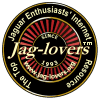Untitled
Fastener Nomenclature
From: Rob Reilly
To: XK lovers
Subject: Fastener Nomenclature
Date: Friday, February 07, 1997 5:44PM
John, you asked about the nut and bolt listings in the
back of the 120 parts catalogue, how to interpret the markings on the bolt
heads, and which were hardened bolts. First the high strength bolts. In
the remarks column there are a few with the letters HTS. This means High
Tensile Strength. The suffix letter in the part no. is F.
I thumbed through the book and found a few suffix F applications:
- fan pulley to damper
- rear springs to chassis frame
- torsion bar flange to wishbone lever
- accelerator linkage brackets
Perhaps a few of us could check some of these for markings
on the heads. High strength steel can also be identified by holding the
part against a grinder; it makes a different spark pattern than low carbon
steel.
Now the numbering scheme:
The factory used the format @@#&&/**% where @@
represents one or two alphabet characters and designates the type of fastener.
- FB is a bolt with British Standard Fine threads (BSF)
- CB is a bolt with American National Coarse threads (ANC
= UNC)
- NB is a bolt with American National FIne threads (ANF
= UNF)
- FC is a bolt with BSF threads and a square neck
- AS is a setscrew with British Association threads (BA)
- CS is a setscrew with ANC threads
- FS is a setscrew with BSF threads
- NS is a setscrew with ANF threads
- WS is a setscrew with BSW threads
- AN is a hex nut with BA threads
- FN is a hex nut with BSF threads
- FU is a steel wing nut
- NN is a hex nut with ANF threads
- AW is a plain flat washer sized for a BA screw
- FG is a spring washer sized for a BSF screw
- FW is a flat or beveled washer sized for a BSF screw
- FT is a stud with BSF threads
- M is a wood screw
- J is a clevis pin
- L is a split pin (cotter pin)
- OD is a dowel pin
- R is a rivet
Then there are some washers and screws with prefix C
or BD which causes confusion with all the other C and BD parts in the rest
of the book.
# the first numeral after the period represents some
characteristic.
For bolts and setscrews:
- 1 is a standard hex head
- 2 is a thin hex head
- 3 is a cheese head
- 4 is a round head
- 5 is a countersunk head
- 6 is an instrument head
For nuts:
- 1 is a plain steel hex nut
- 2 is a lock nut
- 4 is a slotted nut
- 7 is a regular slotted nut
For washers:
- 1 is a plain washer
- 2 is a beveled washer
For woodscrews:
- 1 is a countersunk head
- 2 is a round head
For rivets:
- 3 is a flat head
- 5 is a 90 degree countersunk head
- 6 is a 120 degree countersunk head
&& numerals represents the diameter
** numerals represents the length in eighths of an inch,
except for washers
% is a suffix letter indicating some other characteristic
such as the material its made from or the type of head.
Unfortunately there are many bolts not in this list for
which the part no. is of the format C.####. These are specials that were
made especially for Jaguar or were modified by Jaguar from a standard bolt.
Putting a hole through a bolt for a split pin would be an example. To determine
if any of these were hardened or HTS bolts we would have to check them
individually.
I've probably missed a few, so don't hold me accountable.
In my business I've seen this sort of nomenclature scheme
used for all sorts of industrial goods.
Rob

|

